Hoover Dam Bypass, USA
Feb 24, 20
Hoover Dam Bypass, USA
The Highest Archway in the West, Built Literally in Mid-Air
In the early 2000s, traffic congestion on U.S. Highway 93, which crosses the Hoover Dam to pass over the Colorado River, was becoming not only a menace but also a serious economic burden.
The highway is the major commercial corridor between Arizona, Nevada and Utah as well as on the North American Free Trade Agreement (NAFTA) route between Mexico and Canada. The heavy traffic combined with the sharp highway curves also created a potentially dangerous situation for Hoover Dam visitors and dam facilities.
The $240 million Hoover Dam Bypass, a five year construction project, was initiated in 2005 to alleviate the traffic congestion and provide an alternate crossing of the river near the dam. It comprised 6 km of roadway, eight bridges, wildlife crossings, a 579 m long bridge over the Colorado River as well as pedestrian and visitor improvements.
The Challenge
To build the most technically challenging bridge in North America.
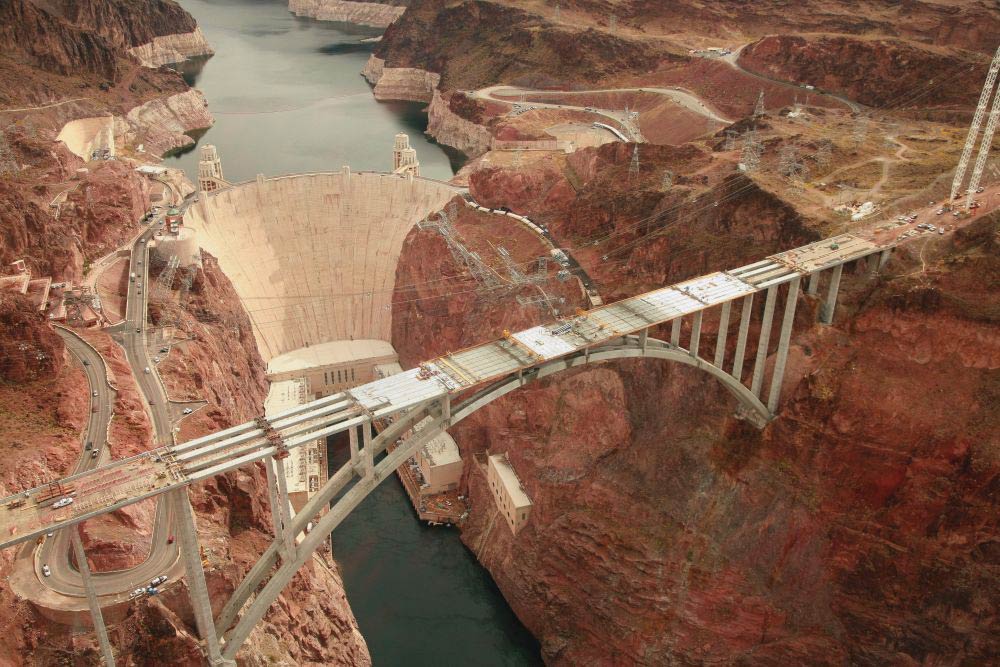
The completed Mike O’ Callaghan-Pat Tillman Memorial Bridge runs parallel to the Hoover Dam across the Colorado River between Arizona and Nevada.
The Solution
The Hoover Dam Bypass, a five-year construction project completed in October 2010, now provides an alternate crossing of the river near the dam. It comprises 6 km of roadway, eight bridges, wildlife crossings, a 579 m long bridge over the Colorado River as well as pedestrian and visitor improvements.
Six Construction Phases
Due to the project’s magnitude, it was divided into six phases. Putzmeister equipment arrived on site in the early stages of the Arizona Approach phase, which included constructing a highway that worked toward the east, while the Nevada Approach highway phase headed west. They connected in the middle at the new Colorado River Bridge, which spans the Black Canyon about 457 m south of the Hoover Dam.
Construction of the $21.5 million Arizona approach began in early 2003. This phase encompasses 2.9 km of four-lane roadway that leads from Arizona U.S. 93 to the new Colorado River Bridge Crossing.
Mountains were literally moved to make way for the roadway and bridge; however, the terrain left behind was extremely steep and rocky. Often, a trail built one day for special access was moved the next. Obviously, these were less than ideal conditions for concrete placing equipment to traverse and set up.
However, the Putzmeister concrete boom pumps used on the job never succumbed to the obstinate terrain and were on-site working about four days a week over a 14-month period. The pumps, ranging from 32 to 58 meters, were supplied by Quinn Concrete Pumping, Inc. (Quinn) of Las Vegas, Nevada – the exclusive concrete pumping sub-contractor for the Arizona Approach.
Two-thirds of the concrete placement was devoted to the grid structure, which included underground diversion channels for water drainage. However, the more visually apparent concrete work could be seen on the Sugarloaf Mountain Bridge, a 274 m long bridge spanning a canyon on the east side of Sugarloaf Mountain. The bridge required eight sets of columns, wide at the base and tapered toward the top. Constructed in a hopscotch manner, the specially-beveled formwork jumped from one to the next.
Critical Bridge Deck Pour
Although all concrete pours were important, the final bridge deck pour was by far the most critical. To the casual observer, nothing unusual was evident. To experienced construction crews, great care was taken to ensure the concrete placing equipment did not break through the new bridge situated 43 m above ground.“The concrete on the bridge was fresh,” notes Steve Heimark, operations manager at Quinn. “Therefore, instead of nosing up to the edge of the last deck pour and using a smaller boom pump to finish the last 18.3 m by 30.5 m section, we felt we had to take all danger out of the equation.
Heimark continues, “As a result, we alerted the general contractor’s engineers to help calculate the structural integrity of one of the bridge’s column. If structurally sound, this would be a safer alternative for positioning concrete placing equipment over the top of it.”
The column was deemed worthy of withstanding the pressure exerted when pumping concrete along with the combined 118,000 kg weight of two ready mix trucks and a M52 boom pump. With the revised setup spot over the top of the bridge’s column, the larger M52 was now needed for more reach.
Although the new setup equation meant a larger sized boom pump, two ready mix trucks could now simultaneously discharge into the pump’s hopper. This was in contrast to accommodating only one mixer at a time with the original plan.
Being exceptionally safety-conscious, Quinn also positioned 1.5m by 2.4m steel trench plates under the boom pump’s front outriggers for added insurance in spreading the load over a wider area.
Quinn Isley, Quinn Concrete Pumping owner, says, “Even the best Vegas mix is the worst mix almost anywhere else in the country, and the mix specs for this project were no exception. A brutal combination of coarse aggregate and coarse sand proved un-pumpable for competitive pumps originally sent out on the job.
However, when our Putzmeister pump with its Big Mouth S-Valve arrived, it gulped down the harsh mix without a problem.”
Positioned mere inches from the edge of a mountainous cliff near the Hoover Dam, a Putzmeister 58-Meter Boom Pump stretched its long 57 m Boom to its fullest extension to pump concrete into the hopper of another Boom Pump situated in a gorge below.
Ironically, the unit underneath – a Putzmeister M42 – was also set up on the edge of yet another cliff, overlooking a river 274 m below. Its boom was also extended to its longest reach at 42 m to pump concrete to its final destination.
Together, these “pumps on the edge” were deemed the only way to effectively place concrete for construction of a large bridge pier. Not just any bridge pier. This one will provide the foundation for vertical columns needed to support the special arch of the new Colorado River Bridge, a vital link of the Hoover Dam Bypass project.
Quinn was once again selected as the concrete pumping subcontractor for the Colorado River Bridge phase. Quinn, with established pumping services since 1998, supplied the Putzmeister equipment and pump operators. In addition, they provided the expertise and creativity to mastermind this challenging concrete placement feat, as well as many others that would follow.
Concrete Boom Pump Conquers Terrain
Before the ‘pump to pump’ pour could commence, a temporary road was specially built for the 42 so it could travel down the steep and rocky slope.
In addition, a 10.7 m by 15.2 m platform was specially graded flat to ensure a structurally sound base for unit setup below. Steve Heimark of Quinn notes, “Originally, we considered a 36-Meter for its lighter weight. However, we had to up-size to a 42-Meter for greater reach.” “It was nerve racking,” adds Heimark, “when this larger boom pump had to travel down an almost 45-degree slope while connected to the cable of a track-hoe excavator.
“All the time, we were relying on the cable's strength not to let the pump escape, which would have sent it plummeting over the ledge and almost a quarter mile down before crashing into the waters below. Fortunately, the unit stayed its course."
The crew worked at night to take advantage of lower summer temperatures and less traffic congestion. However, due to the nature of the pour itself, it still took seven hours to place 290m³ of concrete.
Big Mouth S-Valve Gulps Down Harsh Mix
Casino Ready Mix, Inc. supplied the harsh Vegas mix from a batch plant set up near the project. As ready mix trucks could not traverse down the extreme slope, they would discharge into the hopper of the BSF 58 pump situated atop the upper edge, which in turn, pumped to the other boom pump’s hopper below.
Heimark says, “On other jobs related to the Hoover Dam project, the general contractor had witnessed our Big Mouth S-Valve handle extremely harsh mixes that others just couldn’t pump. As a result, our equipment’s performance was a major factor in being selected.”
Although this was a challenging pour on the bridge’s structure, it was not the most difficult or most unique. Owner Quinn says, “We would handle some of the most unusual and innovative concrete placement techniques ever imagined throughout the various stages of this high-profile project.”
Construction of the $114 million Colorado River Bridge, the heart of the Hoover Dam Bypass Project, features a 579 m long open spandrel deck arch bridge, which arches 274 m above the Colorado River. The 323 m spans of the twin concrete arches are the longest in North America, fourth largest in the world, and reach about 274 m high at the apex.
General contractor for this portion of the project, Obayashi/ PSM JV had its work cut out for them. The project included the pre-casting and erection of pier columns up to 91 m tall; construction of the twin, cast-in-place segment concrete arch spans; and the installation of temporary twin cable stays that have a 762 m span and are 101 m tall to support the arches during construction.
Complete Systems Approach
“We called Putzmeister right away to discuss the complicated project and what our possible concrete placing solutions would be,” says Wes Pollnow, construction manager of Obayashi/PSM JV. “We felt more confident preparing for this project by utilizing Putzmeister’s complete systems approach.”
Detailed input was necessary to make precise calculations that would allow the job to be carried out with the utmost safety and efficiency. Pollnow notes, “The placing system chosen to maximize concrete placement for the arch was the MX 32/36 and MX 36/38 placing booms and BSA 2107 HP-E and BSA 2109 H-E trailer pumps.”
Overcoming the Extreme
Jeff St. John, project manager of Obayashi/PSM JV, says Putzmeister also helped their team determine how and where to strategically mount the placing booms and position the trailer pumps for all portions of the complex project.
“For construction of the twin arches, we positioned one trailer pump near the base of the Nevada arches and one on top of the arch footing in Arizona,” comments St. John. “A placing boom was also positioned on each the Nevada and Arizona side of the twin arches.”
The separate placing booms and their pedestals were flown via crane to each of the twin arches for mounting on their specially designed platforms.
Once the placing booms and trailer pumps were in position, they were ready to step up to overcome the still problematic heat and place the harsh Nevada concrete mix up 85 m and out 162 m.
“All of the concrete mixes used for the arch were advanced concrete mix designs using harsh aggregates,” says St. John. “Liquid nitrogen was used extensively for pre-cooling of the concrete in order to reduce the temperature the concrete reaches during curing.”
For the arches, a high-strength 10,000-psi concrete mix was used, and for the columns and pier caps, a high-strength 6,000-psi mix.
“Even with the combination of the heat and the harsh mix, the trailer pumps were able to easily maintain a continuous concrete flow, at a timely pace, up to the placing booms so it would not clog the pipe system in the extreme conditions,” comments Pollnow. “In addition, the S-Valves on the pumps had no problem gulping down the tough concrete mixes.”
The trailer pumps are able to provide a smooth, more controllable output of concrete because of each pump’s free flow hydraulic technology. Both pumps have a fully adjustable volume control to allow very slow pumping while retaining full concrete pressure.
The pumps outputs ranged around 12m3/hr due to the site's extraordinary environment conditions.As done before, most concrete was placed at night to avoid the intense heat and avoid traffic congestion.
Pollnow adds, “The Putzmeister pumps really provided that extra muscle we needed to push the concrete up and out to its final destination; and in fact, both trailer pumps have the capability to pump concrete up to 244 m high.
“Also, the capabilities of the placing booms helped immensely to reach the exact point of concrete placement for each segment of the twin arches. Again, because of the unconventional setup, we really needed dependable booms, and they did not disappoint.”
Sightseeing visitors at the Hoover Dam witnessed an unusual sight in April 2010 when a Putzmeister M52 Semi-Trailer-Mounted Concrete Boom Pump was flown above the Colorado River during the final stages of the historical Colorado River Bridge Project.
The boom pump, owned by Quinn, was carefully placed atop the partially constructed Colorado River Bridge using a cableway system developed specifically for the bridge project. The boom pump was used to place concrete on the bridge deck spanning nearly 610 m and connecting the Arizona and Nevada Approaches over the Black Canyon.
Each phase of construction presented unique challenges – with the final stage proving no different.
By April 2010, most of the bridge was finished: the precast foundation columns had been set, the concrete twin arches were joined together, the steel girders were erected and the outer bridge deck and barriers were already cast. It was time to start work on the 11 separate deck pours; each pour would be 26 m wide and approximately 36 m long. It would be no easy task, but the Putzmeister equipment was up for the challenge.
Complete Systems Approach
Since early 2005, the general contractor had utilized Putzmeister’s complete systems approach for assistance in the selection and positioning of equipment. For the next feat, they would again rely on the manufacturer’s expertise.
Alan Woods, Putzmeister field service technician says, “The general contractor worked diligently with us and the pumping contractor to determine the exact calculations, balances, picking points and appropriate counterweights to ensure that everything went off smoothly and safely.”
Because of the large area each deck pour covered, which had to be poured symmetrically on both sides, the decision was made to use Quinn’s M52 semi-trailer-mounted concrete boom pump.
With the M52’s impressive 52 m vertical and 48 m horizontal reach, handling the 37 m deck pours would be no problem. Instead the challenges lay elsewhere: flying the boom pump up to the deck, pumping in tight quarters, balancing deck pours on the bridge, and pumping concrete to the M52.
Transporting the boom pump up to the deck was handled with precision via the cableway system that had been used successfully throughout the project to deliver materials and equipment. However, before the boom pump could be flown to the deck, the crew had to address space requirements on the bridge.
Putzmeister took a highly innovative approach to solving this issue. To save on flyweight and reduce the unit’s footprint, the boom pump was detached from the tractor. The boom pump’s versatile semi-trailer design, with a separate diesel engine, allowed it to be easily detached, flown to the bridge deck, and then attached to a specially-designed concrete counterweight that simulated the weight of the tractor and took up less space.
“The M52 was basically being used like a placing boom,” says Woods.
Because the arch of the bridge had to be loaded symmetrically, the boom pump and counterweight were set up in the middle of the bridge. Then, to ensure everything stayed balanced, one deck section was poured on one side of the boom pump, and another deck section was poured on the other side of the boom pump. The boom was then lifted and turned to continue the pour in this manner, going back and forth during the entire deck pour.
For the deck pours, a harsh 4,500-psi mix with fibers in it was used to help control cracking on the deck. Because this was such a tough dry mix, using the right trailer pump was crucial.
Another challenge was how far up the concrete would need to be pumped. The crew decided to use Quinn’s BSA 14000 to pump up through 213 m of pipeline. With the highest pressures and outputs available, the high-performance trailer pump easily maintained a continuous flow of the harsh mix and facilitated the long-distance concrete pumping.
“First, we pumped up the pipeline and into the hopper of the Putzmeister M52, which then pumped the rest of the way,” explains Pollnow. “The trailer pump really provided the power we needed to push the concrete up and out to its final destination. It averaged 54m3/hr and at one point reached 76m3/hr. The Trailer Pump provided a smooth, controllable output of concrete because of its free flow hydraulic technology.
“Throughout the highly technical job, the crew never encountered even one minor problem with the high pressure trailer pumps or separate placing booms; and beyond the equipment’s reliable performance, kudos went to Quinn also. “Quinn was on site early on in the project placing concrete in difficult situations,” notes St. John. “They are a great team to work with, very dependable.”
A Job Well Done
Successful completion of the Hoover Dam Bypass project, a truly impressive feat of engineering, highlighted the expertise of personnel to design an unusual yet efficient concrete placing plan; as well as the equipment’s versatility and reliability to accomplish numerous concrete placement tasks never attempted before. A celebration and dedication ceremony applauded the project’s success, and traffic began using the bypass on October 19, 2010.
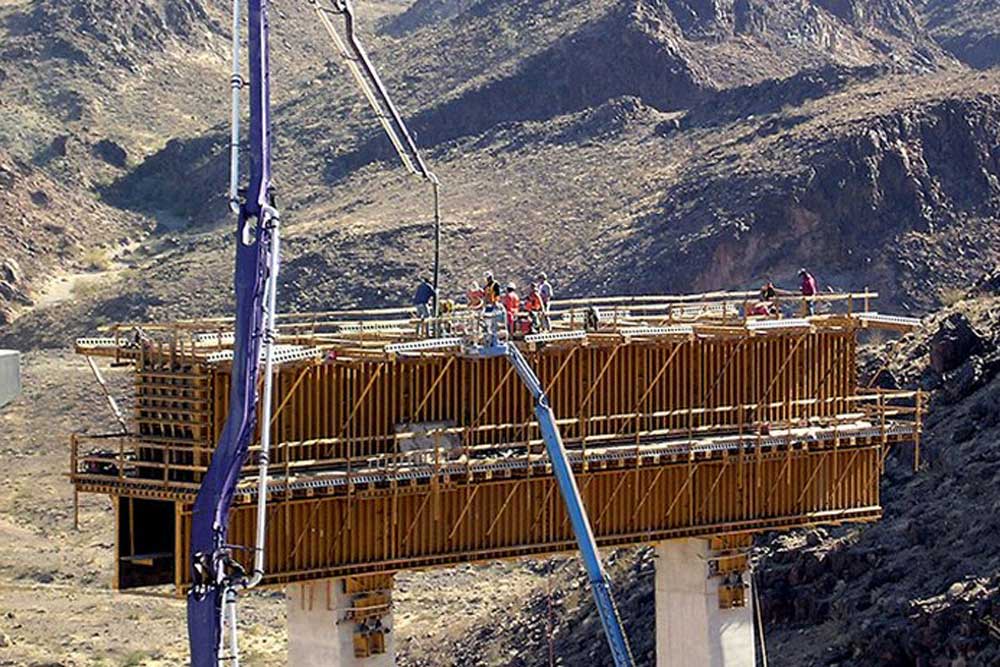
Putzmeister pumps were used to place concrete for the construction of the bridge pier that served as the foundation of the vertical columns
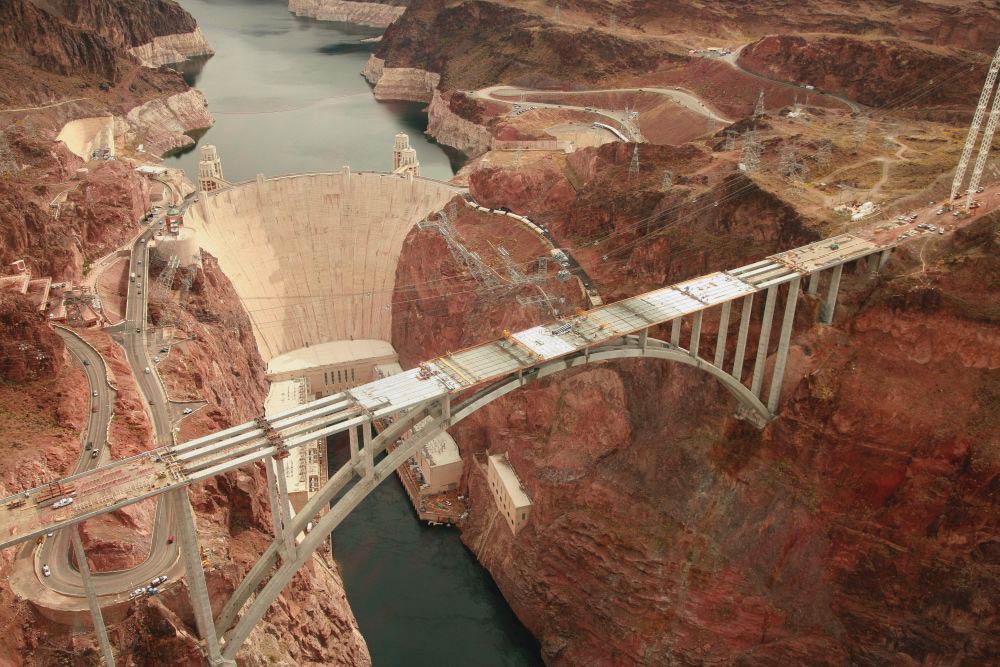
The Colorado River Bridge is part of the Hoover Dam Bypass project. The 610 m bridge is being built to alleviate traffic on U.S. Highway 93, which currently crosses the Hoover Dam to pass over the Colorado River.
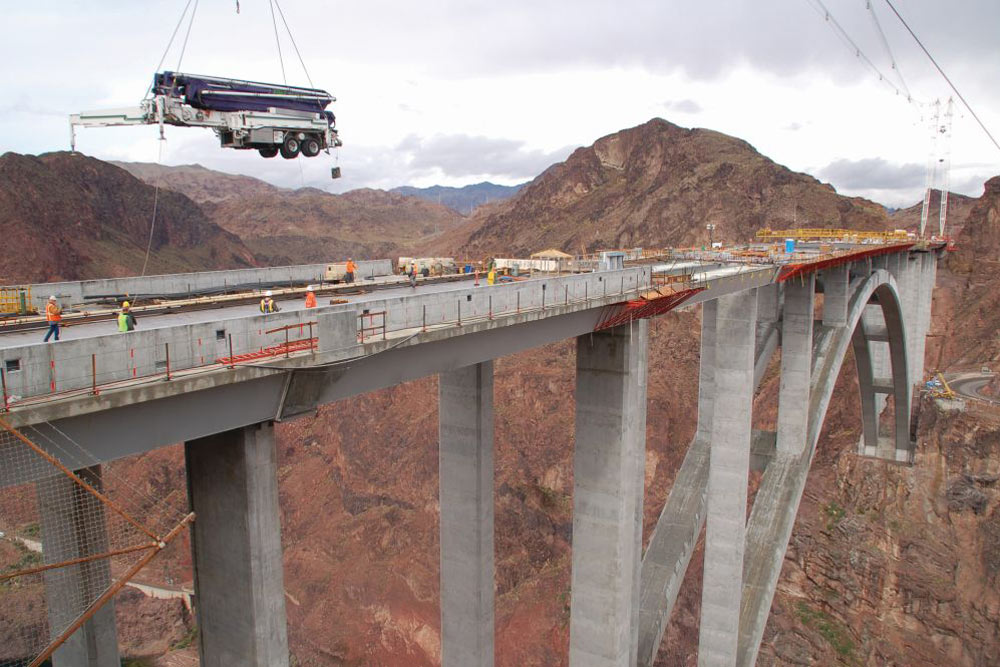
As crews begin the final stages of the historical Colorado River Bridge project, a Putzmeister M52 truck-mounted concrete boom pump is flown over 274 m above the Colorado River for concrete placement of the driving deck.
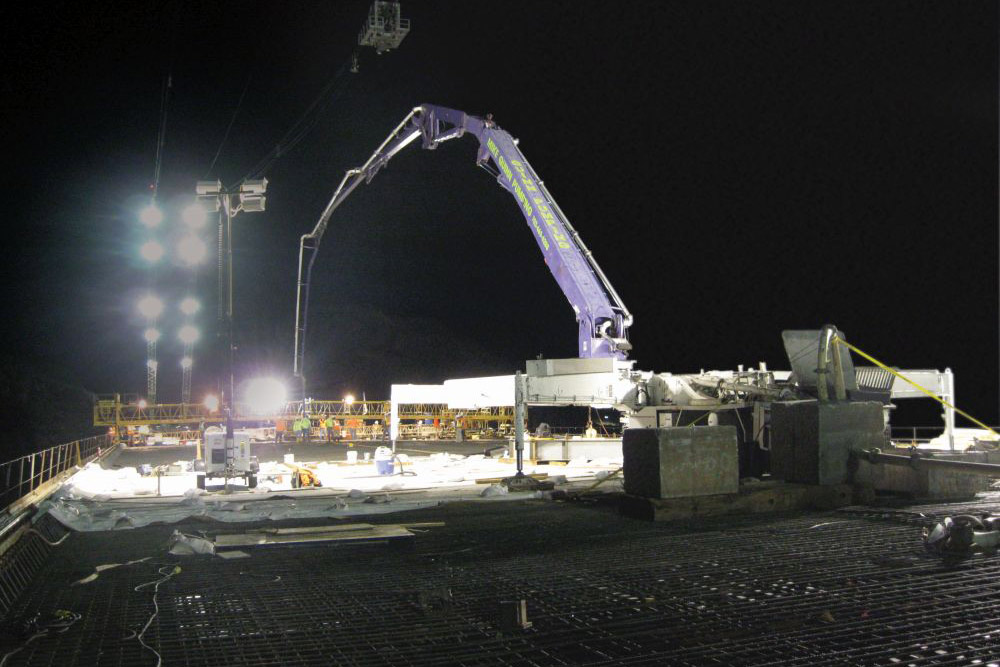
Much of the concrete placement occurred at night in an attempt to avoid pumping in the heat and traffic congestion.
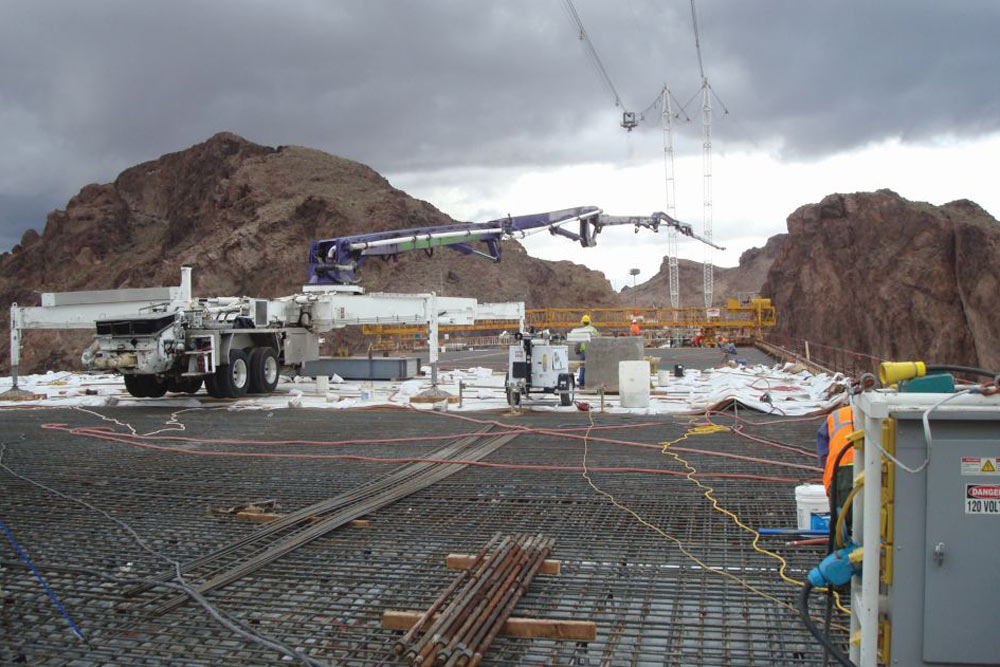
With the M52's impressive 52 m vertical and 48 m horizontal reach, handling the 37 m deck pours was no problem.
Concrete Takeaways
- Traffic began on the Hoover Dam Bypass on October 19, 2010.
- The $114 million Colorado River Bridge is now officially named the Mike O'Callaghan - Pat Tillman Memorial Bridge.
- The 323 m spans of the twin concrete arches of the Colorado River Bridge are the longest in North America, and fourth largest in the world.
- A Putzmeister M52 Semi-Trailer-Mounted Concrete Boom Pump was flown above the Colorado River during the final stages of the historical Colorado River Bridge Project.
Project Partners
Owner/Developer:
Federal Highway Administration – Washington, D.C.; Arizona, Department of Transportation – Phoenix, Arizona; Nevada, Department of Transportation – Carson City, Nevada; U.S., Bureau of Reclamation; National Park Service; Western Area, Power Administration – Lakewood, Colorado
Design Team:
T.Y. Lin International – San Francisco, California; HD, Engineering – Las Vegas, Nevada with corporate headquarters in Omaha, Nebraska; Sverdrup Civil, Inc.
Colorado River Bridge – General Contractor, Concrete Pump Supplier, Ready Mix Supplier:
Obayashi/ PSM JV, a joint venture of Obayashi Corporation and PSM Construction USA, Inc. – Boulder City, Nevada
Arizona Approach – General Contractor:
Joint venture of R.E. Monks Construction and Vastco Inc.--Fountain Hills, Arizona
Ready Mix Suppliers until 2007:
Casino Ready Mix, Inc. – Las Vegas, Nevada, Silver State Materials (now a part of the CalPortland Company) – Las Vegas, Nevada
Concrete Pumping Subcontractor:
Quinn Concrete Pumping, Inc. – Las Vegas, Nevada